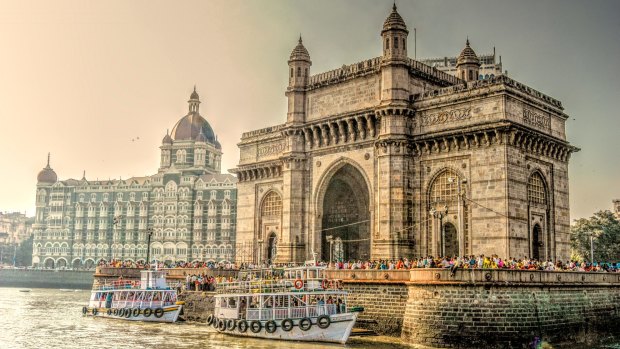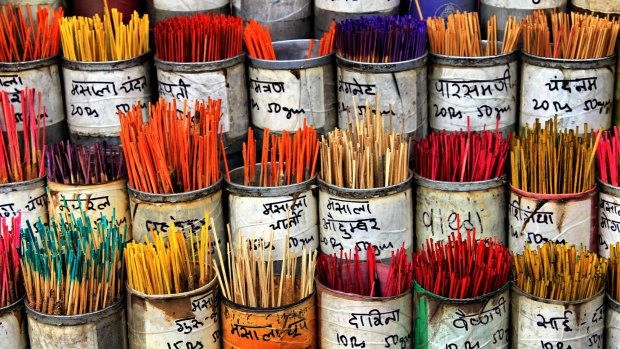By Nina Karnikowski

The Gateway of India, by the and Taj Mahal Palace Hotel.Credit: Chidanand M.
Bombay is a crowd, as the great V.S. Naipaul once said. Even when it's sleeping, it seems this morning. My husband and I tiptoe over the dozens of slumbering bodies lining Colaba Causeway, the main street of Mumbai's southernmost suburb of Colaba just before dawn.
We touched down on Indian soil only an hour ago and were only too happy to wander the streets of India's city of dreams until our hotel room was ready. This is our old stomping ground, after all. Three years ago we lived in this suburb of Mumbai, India's largest, most prosperous city and the home of Bollywood cinema, for nine months. In that apartment building right there, in fact – one of the mildewed, grimy ones that seemed constantly on the verge of collapse. A result of the assault of excessive sun, rain, heat and crowds that in the end drove us back to home soil.
We do as we used to and cross the road to sit on the sea wall facing the local fishing slum, gazing across to the "beach" where litter has replaced sand and colourful wooden fishing boats bob in the Arabian Sea.

Colorful incense sticks in a shop outside Dadar train station in Mumbai.Credit: FragmentOne
"If you blur your eyes, so you can't see the rubbish or those people going to the loo on the shore, it's almost pretty," says my husband hopefully. I squint my eyes and sure enough, only the candy-coloured shanty houses and waving palm trees remain. Proof, perhaps, that when viewed in a different way, everything irritating about India can become a source of pleasure.
The sky starts to lighten and we wander along Strand Promenade, passing a lone chai seller and a squeeze of grand whitewashed buildings shrouded in hot pink bougainvillea. Soon we reach the majestic Gateway of India, Mumbai's most iconic monument, which was built to mark the spot where King George V and Queen Mary first landed in India in 1911. The lava lamp sun floats clear of the horizon and wobbles through the pre-monsoonal haze, casting a syrupy yellow light over the hundreds of pecking pigeons beneath the gateway.
It's steamy and sticky and it's only 6.30am. Luckily, we have only to walk across the road to the Taj Mahal Palace Hotel. As we enter our luxurious home for the next two nights, we're immediately transported into another world.
When viewed in a different way, everything irritating about India can become a source of pleasure.
At reception we're welcomed with a sacred orange tikka mark to the forehead and some wooden tulsi mala beads around our necks, which supposedly attract purity and ward off evil. Our porter ushers us through jasmine-scented hallways towards the lifts, telling us we're walking over semi-precious stones including jade and emerald embedded into the marble beneath our feet. I feel a twinge of discomfort at all the lavishness, but remind myself that it was these extremes and contradictions lying at the heart of Mumbai life that I'd loved so much about the city.
Our heritage room is a rather posh affair, with its Turkish marble bath, views over the pool and fresh white roses on the table. But we're only inside it for 10 minutes before rushing down to the pool.
A rare oasis of calm in this city of 12 million, the Taj pool is surrounded by lush frangipani and palm gardens, embroidered umbrellas and enthusiastically spurting sandstone lions. We sink happily into its vortex until it's time for a decadent lunch at Masala Kraft, the Taj's modern Indian grill and one of the property's 10 restaurants and bars. There we feast on spicy grilled meats, cooked in front of us on an open fire, until we're ready to launch back out into the melee.
Before we do, though, we're given a subtle reminder of a devastating part of the hotel's history. A memorial wall we come across at reception is inscribed with the names of the 31 guests and workers killed in the 2008 terrorist bombings there. Next to it sits a six-foot bronze tree sculpture, dubbed the "tree of life" after it survived the attacks without any damage. "We put the tree there because we wanted the memorial wall to be a sign of life, not a sign of loss," a staff member tells me later. "Because we believe no matter what happens, life still goes on."
Life is certainly still going on back on Colaba Causeway, by now a rumpus of hawkers and street vendors selling everything from peacock feather fans and small drums, to chunks of crystal and other vaguely eastern chintz. Pushing through the din and the dust, we pass the palm-fringed Oval Maidan where dozens of young boys dressed in pristine whites play cricket, and make our way to Marine Drive. We reach the 3.5-kilometre seaside boulevard and are immediately overwhelmed by hundreds of black and yellow taxis, cars, bikes, buses, trucks, people, and even the odd cow, rushing along beside us.
Our intention was to walk all the way to Chowpatty Beach, but we escape the frenzied honk and blare halfway by heading up to Dome, the elegant all-white rooftop bar of the Intercontinental Hotel and the city's top spot from which to watch the sun sink into the Arabian Sea. Which is exactly what we do, cucumber gimlets raised to this marvellous city of contradictions, as the sky turns black and the lights of Marine Drive begin to sparkle.
Nina Karnikowski was a guest of the Taj Mahal Palace Hotel.
TRIP NOTES
MORE INFORMATION
GETTING THERE
Singapore Airlines flies from Sydney and Melbourne to Mumbai via Singapore from about $1000 return. See singaporeair.com.
STAYING THERE
The Taj Mahal Palace Mumbai offers 550 rooms and suites, with room rates starting at $223 a night including breakfast. See taj.tajhotels.com.
TOURING THERE
Mantra Wild Adventures offers a nine-day Luxury India Palace private tour including Delhi, Jaipur, Udaipur and Mumbai, which includes two nights at Mumbai's Taj Mahal Palace, as well as other Taj properties. $3999 a person for those travelling before September 30; see mantrawild.com.au.
Sign up for the Traveller Deals newsletter
Get exclusive travel deals delivered straight to your inbox. Sign up now.